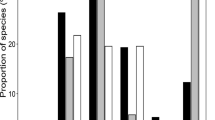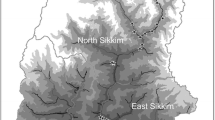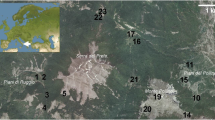Abstract
A long-standing task for ecologists and biogeographers is to reveal the underlying mechanisms accounting for the geographic pattern of species diversity. The number of hypotheses to explain geographic variation in species diversity has increased dramatically during the past half century. The oldest and the most popular one is environmental determination. However, seasonality, the intra-annual variability in climate variables has been rarely related to species richness. In this study, we assessed the relative importance of three environmental hypotheses: energy, seasonality and heterogeneity in explaining species richness pattern of butterflies in Eastern China. In addition, we also examined how environmental variables affect the relationship between species richness of butterflies and seed plants at geographic scale. All the environmental factors significantly affected butterfly richness, except sampling area and coefficient of variation of mean monthly precipitation. Energy and seasonality hypotheses explained comparable variation in butterfly richness (42.3 vs. 39.3 %), higher than that of heterogeneity hypothesis (25.9 %). Variation partitioning indicated that the independent effect of seasonality was much lower (0.0 %) than that of energy (5.5 %) and heterogeneity (6.3 %). However, seasonality performed better in explaining butterfly richness in topographically complex areas, reducing spatial autocorrelation in butterfly richness, and more strongly affect the association between butterflies and seed plants. The positive relationship between seed plant richness and butterfly richness was most likely the result of environmental variables (especially seasonality) influencing them in parallel. Insufficient sampling may partly explain the low explanatory power of environmental model (52.1 %) for geographic butterfly richness pattern. Our results have important implications for predicting the response of butterfly diversity to climate change.






Similar content being viewed by others
References
Ackerly DD, Loarie DR, Cornwell WK, Weiss SB, Hamilton H, Branciforte R, Kraft NJB (2010) The geography of climate change: implications for conservation biogeography. Divers Distrib 16:476–487
Ahn CH, Tateishi R (1994) Development of a global 30-minute grid potential evapotranspiration data set. ISPRS J Photogramm Remote Sens 33:12–21
Allen AP, Gillooly JF, Brown JH (2007) Recasting the species-energy hypothesis: the different roles of kinetic and potential energy in regulating biodiversity. In: Storch D, Marquet PA, Brown JH (eds) Scaling Biodiversity. Cambridge University Press, Cambridge
Andrews P, O’Brien E (2000) Climate, vegetation, and predictable gradients in mammal species richness in southern Africa. J Zool 251:205–231
Badgley C, Fox DL (2000) Ecological biogeography of North American mammals: species density and ecological structure in relation to environmental gradients. J Biogeogr 27:1437–1467
Bale JS, Masters GJ, Hodkinson ID, Awmack C, Bezemer TM, Brown VK, Butterfield J, Buse A, Coulson JC, Farrar J, Good JEG, Harrington R, Hartley S, Jones TH, Lindroth RL, Press MC, Symrnioudis I, Watt AD, Whittaker JB (2002) Herbivory in global climate change research: direct effects of rising temperature on insect herbivores. Glob Change Biol 8:1–16
Bini LM, Diniz-Filho JAF, Rangel TFLVB, Akre TSB, Albaladejo RG, Albuquerque FS, Aparicio A, Araújo MB, Baselga A, Beck J, Bellocq MI, Böhning-Gaese K, Borges PAV, Castro-Parga I, Chey VK, Chown SL, De Marco P Jr, Dobkin DS, Ferrer-Castán D, Field R, Filloy J, Fleishman E, Gómez JF, Hortal J, Iverson JB, Kerr JT, Kissling WD, Kitching IJ, León-Cortés JL, Lobo JM, Montoya D, Morales-Castilla I, Moreno JC, Oberdorff T, Olalla-Ta′rraga MÁ, Pausas JG, Qian H, Rahbek C, Rodríguez MÁ, Rueda M, Ruggiero A, Sackmann P, Sanders NJ, Terribile LC, Vetaas OR, Hawkins BA (2009) Coefficient shifts in geographical ecology: an empirical evaluation of spatial and non-spatial regression. Ecography 32:193–204
Boggs CL, Murphy DD (1997) Community composition in mountain ecosystems: climatic determinants of montane butterfly distributions. Glob Ecol Biogeogr Lett 6:39–48
Carrara R, Vázquez DP (2010) The species-energy theory: a role for energy variability. Ecography 33:942–948
Chesson P, Huntly N (1997) The roles of harsh and fluctuating conditions in the dynamics of ecological communities. Am Nat 150:519–553
Chou I (2000) Monographia Rhopalocerorum Sinensium, 2nd edn. Henan Science and Technology Press, Zhengzhou
Clarke A, Gaston KJ (2006) Climate, energy and diversity. Proc Roy Soc B 273:2257–2266
Diniz-Filho JAF, Bini LM, Hawkins BA (2003) Spatial autocorrelation and red herrings in geographical ecology. Glob Ecol Biogeogr 12:53–64
Dutilleul P (1993) Modifying the t test for assessing the correlation between two spatial processes. Biometrics 49:305–314
Evans KL, Warren PH, Gaston KJ (2005) Species-energy relationships at the macroecological scale: a review of the mechanisms. Biol Rev 80:1–25
Field R, Hawkins BA, Cornell HV, Currie DJ, Diniz-Filho JAF, Guégan JF, Kaufman DM, Kerr JT, Mittelbach GG, Oberdorff T, O’Brien EM, Turner JRG (2009) Spatial species-richness gradients across scales: a meta-analysis. J Biogeogr 36:132–147
Fleishman E (2010) Understanding species richness gradients informs projected responses to climate change. J Biogeogr 37:1175–1176
Gaston KJ, Blackburn TM, Loder N (1995) Which species are described first?: the case of North American butterflies. Biodivers Conserv 4:119–127
Gotthardt K, Nylin S, Wiklund C (2000) Mating opportunity and the evolution of sex-specific mortality rates in a butterfly. Oecologia 122:36–43
Hawkins BA, Porter EE (2003a) Water-energy balance and the geographic pattern of species richness of western Palearctic butterflies. Ecol Entomol 28:678–686
Hawkins BA, Porter EE (2003b) Does herbivore diversity depend on plant diversity? the case of California butterflies. Amer Naturalist 161:40–49
Hawkins BA, Field R, Cornell HV, Currie DJ, Guegan JF, Kaufman D, Kerr JT, Mittelbach G, Oberdorff T, O’Brien EM, Porter EE, Turner JRG (2003) Energy, water, and broad-scale geographic patterns of species richness. Ecology 84:3105–3117
Heikkinen RK, Luoto M, Kuussaari M, Pöyry J (2005) New insights into butterfly environment relationships using partitioning methods. Proc R Soc B 272:2203–2210
Hijmans RJ, Cameron SE, Parra JL, Jones PG, Jarvis A (2005) Very high resolution interpolated climate surfaces for global land areas. Int J Climato 25:1965–1978
Kerr JT (1999) Weak links: ‘‘Rapoport’s rule’’ and large-scale species richness patterns. Global Ecol Biogeogr 8:47–54
Kerr JT, Southwood TRE, Cihlar J (2001) Remotely sensed habitat diversity predicts butterfly species richness and community similarity in Canada. Proc Nat Acad Sci USA 98:11365–11370
Kerr JT, Kharouba HM, Currie DJ (2007) The macroecological contribution to global change solutions. Science 316:1581–1584
Kissling WD, Rahbek C, Böhning-Gaese K (2007) Food plant diversity as broad-scale determinant of avian frugivore richness. Proc R Soc B 274:799–808
Kissling WD, Field R, Korntheuer H, Heyder U, Böhning-Gaese K (2010) Woody plants and the prediction of climate-change impacts on bird diversity. Proc R Soc B 365:2035–2045
Kitahara M, Yumoto M, Kobayashi T (2008) Relationship of butterfly diversity with nectar plant species richness in and around the Aokigahara primary woodland of Mount Fuji, central Japan. Biodivers Conserv 17:2713–2734
Legendre P, Legendre L (1998) Numerical Ecology, 2nd, English edn. Elsevier Science BV, Amsterdam
Lennon JJ, Koleff P, Greenwood JJD, Gaston KJ (2004) Contribution of rarity and commonness to patterns of species richness. Ecol Lett 7:81–87
Menéndez R, González-Megías A, Collingham Y, Fox R, Roy DB, Ohlemüller R, Thomas CD (2007) Direct and indirect effects of climate and habitat factors on butterfly diversity. Ecology 88:605–611
Qian H (2008) Effects of historical and contemporary factors on global patterns in avian species richness. J Biogeogr 35:1362–1373
Qian H, Wang X, Wang S, Li Y (2007) Environmental determinants of amphibian and reptile species richness in China. Ecography 30:471–482
Qian H, Wang S, Li Y, Wang X (2009) Breeding bird diversity in relation to environmental gradients in China. Acta Oecol 35:819–823
Quinn GP, Keough MJ (2002) Experimental design and data analysis for biologists. Cambridge University Press, Cambridge
R Development Core Team (2009) R: A language and environment for statistical computing, version 2.12.2. R Foundation for Statistical Computing (online). Available from: http://www.R-project.org
Rangel TF, Diniz-Filho JAF, Bini LM (2010) SAM: a comprehensive application for Spatial Analysis in Macroecology. Ecography 33:46–50
Ruggiero A, Hawkins BA (2008) Why do mountains support so many species of birds? Ecography 31:306–315
Ruggiero A, Kitzberger T (2004) Environmental correlates of mammal species richness in South America: effects of spatial structure, taxonomy and geographic range. Ecography 27:401–416
Schuldt A, Assmann T (2009) Environmental and historical effects on richness and endemism patterns of carabid beetles in the western Palaearctic. Ecography 32:705–714
Tateishi R, Ahn CH (1996) Mapping evapotranspiration and water balance for global land surfaces. ISPRS J Photogram Remote Sens 51:209–215
Tello JS, Stevens RD (2010) Multiple environmental determinants of regional species richness and effects of geographic range size. Ecography 33:796–808
Turner JRG, Gatehouse CM, Corey CA (1987) Does solar energy control organic diversity? Butterflies moths and the British climate. Oikos 48:195–205
White PJT, Kerr JT (2007) Human impacts on environment-diversity relationships: evidence for biotic homogenization from butterfly species richness patterns. Global Ecol Biogeogr 16:290–299
Williams SE, Middleton J (2008) Climatic seasonality, resource bottlenecks, and abundance of rainforest birds: implications for global climate change. Divers Distrib 14:69–77
Willig MR, Kaufman DM, Stevens RD (2003) Latitudinal gradients of biodiversity: pattern, process, scale, and synthesis. Annu Rev Ecol Evol Syst 34:273–309
Willott SJ (2001) Species accumulation curves and the measure of sampling effort. J Appl Ecol 38:484–486
Zhang J, Kissling WD, He F (2013) Local forest structure, climate and human disturbance determine regional distribution of boreal bird species richness in Alberta, Canada. J Biogeogr 40:1131–1142
Acknowledgments
We thank Jan Beck of Universität Basel, and Hong Qian of Illinois State Museum for comments on previous versions of the manuscript. We thank three anonymous reviewers for helpful suggestions. S. Chen thanks his new son, Jiayou Chen, for his encouragement. Financial support from the National Key Technology R&D Program (2012BAC01B08) and the Special Public Science and Technology Research Program for Environmental Protection (201209027) was also acknowledged.
Author information
Authors and Affiliations
Corresponding author
Additional information
Communicated by Peter J. T. White.
Electronic supplementary material
Below is the link to the electronic supplementary material.
Rights and permissions
About this article
Cite this article
Chen, S., Mao, L., Zhang, J. et al. Environmental determinants of geographic butterfly richness pattern in eastern China. Biodivers Conserv 23, 1453–1467 (2014). https://doi.org/10.1007/s10531-014-0676-8
Received:
Revised:
Accepted:
Published:
Issue Date:
DOI: https://doi.org/10.1007/s10531-014-0676-8




